
A manuscript was, traditionally, any document written by hand or typewritten, as opposed to mechanically printed or reproduced in some indirect or automated way. More recently, the term has come to be understood to further include any written, typed, or word-processed copy of an author's work, as distinguished from the rendition as a printed version of the same.
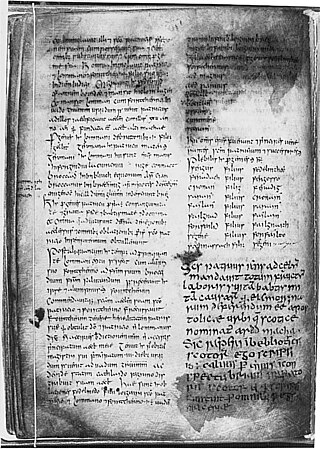
The Book of Armagh or Codex Ardmachanus, also known as the Canon of Patrick and the Liber Ar(d)machanus, is a 9th-century Irish illuminated manuscript written mainly in Latin. It is held by the Library of Trinity College Dublin. The document is valuable for containing early texts relating to St Patrick and some of the oldest surviving specimens of Old Irish, and for being one of the earliest manuscripts produced by an insular church to contain a near complete copy of the New Testament.
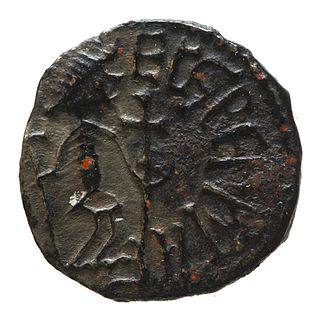
Ecgbert was an 8th-century cleric who established the archdiocese of York in 735. In 737, Ecgbert's brother became king of Northumbria and the two siblings worked together on ecclesiastical issues. Ecgbert was a correspondent of Bede and Boniface and the author of a legal code for his clergy. Other works have been ascribed to him, although the attribution is doubted by modern scholars.
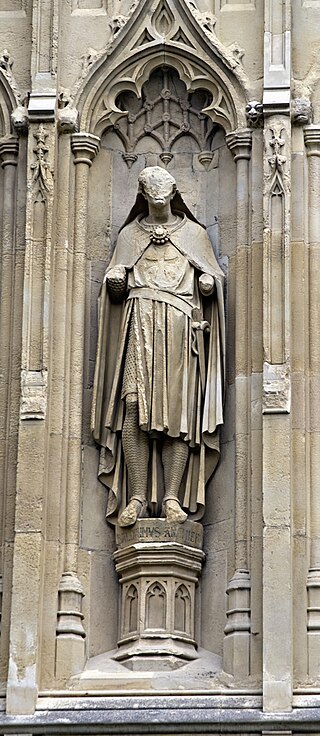
Baldwin of Forde or Ford was Archbishop of Canterbury between 1185 and 1190. The son of a clergyman, he studied canon law and theology at Bologna and was tutor to Pope Eugene III's nephew before returning to England to serve successive bishops of Exeter. After becoming a Cistercian monk he was named abbot of his monastery at Forde and subsequently elected to the episcopate at Worcester. Before becoming a bishop, he wrote theological works and sermons, some of which have survived.
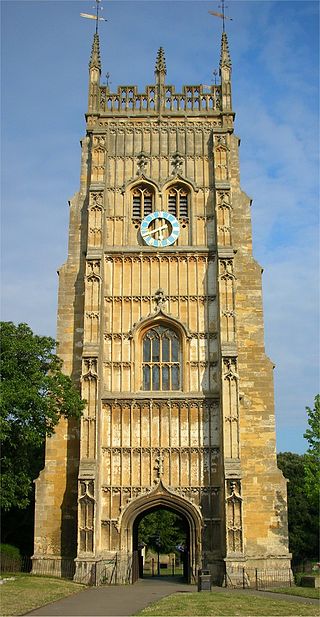
Dominic of Evesham was a medieval prior of Evesham Abbey in England and writer of religious texts. Probably a native Englishman, there is some confusion about when he became a monk, but by 1104 he was at Evesham and by 1125 he held the office of prior. He is chiefly known for his religious works, including one on the miracles of the Virgin Mary that was an important source for later writings on the subject. Four of his works are still extant.
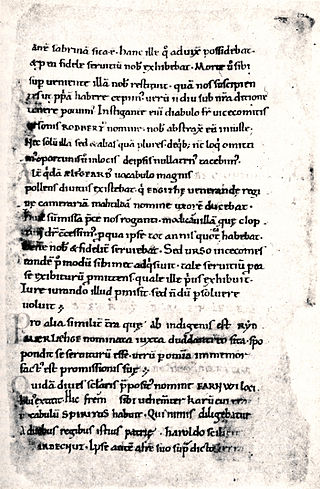
Hemming's Cartulary is a manuscript cartulary, or collection of charters and other land records, collected by a monk named Hemming around the time of the Norman Conquest of England. The manuscript comprises two separate cartularies that were made at different times and later bound together; it is in the British Library as MS Cotton Tiberius A xiii. The first was composed at the end of the 10th or beginning of the 11th century. The second section was compiled by Hemming and was written around the end of the 11th or the beginning of the 12th century. The first section, traditionally titled the Liber Wigorniensis, is a collection of Anglo-Saxon charters and other land records, most of which are organized geographically. The second section, Hemming's Cartulary proper, combines charters and other land records with a narrative of deprivation of property owned by the church of Worcester.
Billfrith is an obscure Northumbrian saint credited with providing the jewel and metalwork encrusting the former treasure binding of the Lindisfarne Gospels. His name is thought to mean "peace of the two-edge sword".
Indract or Indracht was an Irish saint who, along with his companions, was venerated at Glastonbury Abbey, a monastery in the county of Somerset in south-western England. In the High Middle Ages Glastonbury tradition held that he had been an Irish pilgrim — a king's son – on his way back from Rome who was molested and killed by a local thegn after he had stopped off to visit the shrine of St Patrick. This tradition synchronised his life with that of King Ine (688–726), though historian Michael Lapidge has argued that he is most likely to represent a 9th-century abbot of Iona named Indrechtach ua Fínnachta.
Reginald of Canterbury was a medieval French writer and Benedictine monk who lived and wrote in England in the very early part of the 12th century. He was the author of a number of Latin poems, including an epic entitled Malchus, which still survives.

Frithegod, was a poet and clergyman in the mid 10th-century who served Oda of Canterbury, an Archbishop of Canterbury. As a non-native of England, he came to Canterbury and entered Oda's service as a teacher and scholar. After Oda's death he likely returned to the continent. His most influential writing was a poem on the life of Wilfrid, an 8th-century bishop and saint, named Breviloquium Vitae Wilfridi. Several manuscripts of this poem survive, as well as a few other of Frithegod's poems. He was also known for the complexity of his writings, with one historian even calling them "damnably difficult".
John of Tynemouth was a medieval English clergyman and canon lawyer. He was among the first teachers of canon law at what later became Oxford University, where he was by 1188. By the late 1190s John had joined the household of the Archbishop of Canterbury, Hubert Walter. Besides his position in the household, he also held a number of ecclesiastical positions, which earned him a substantial income. After Walter's death, John continued to serve as a lawyer as well as hold clerical offices. He died in 1221 and a number of his writings survive.

Lawrence of Durham was a 12th-century English prelate, Latin poet and hagiographer. Born in southern England, at Waltham in Essex, Lawrence was given a religious education, and excelled at singing and poetry composition. In his youth Lawrence joined Durham Cathedral Priory and became a Benedictine monk. In the 1130s Lawrence became a courtier of Geoffrey Rufus, bishop of Durham.
John of Tynemouth was a medieval English chronicler who flourished in the mid-14th century.
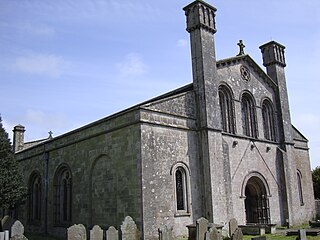
The White Book of Hergest was an important Welsh manuscript compiled in c. 1450. It contained many Welsh poems and prose texts and was a significant source for several antiquaries of the 17th and 18th centuries, but disappeared in the early 19th century, probably being destroyed in a fire in a London bookbinder's shop in around 1810.
William of Wycombe was an English cleric and biographer who became head of the Augustinian priory of Llanthony and wrote a eulogistic life of his friend and patron Robert de Bethune.
Robert of Cricklade was a medieval English writer and prior of St Frideswide's Priory in Oxford. He was a native of Cricklade and taught before becoming a cleric. He wrote several theological works as well as a lost biography of Thomas Becket, the murdered Archbishop of Canterbury.
Clement of Llanthony was an Anglo-Norman clergyman and theologian who became prior of Llanthony Priory. Clement became a canon at Llanthony at a young age, and was educated there. Having held the office of sub-prior, he became prior around 1150, and died sometime after 1167, although the year is not known.

William Ketel was a medieval English writer and clergyman. Little is known about the author, but his work survives in a transcription of a now-lost manuscript. The composition was a compilation of miracles relating to Saint John of Beverley as well as his cult. Most of the stories are known from other works, and the main historical value of Ketel's compilation lies in its information on the growth of the saint's cult and of Beverley Minster. The collection has been published as part of the Rolls Series.
Gervase of Chichester was an English clergyman and writer active in the late 12th century.










